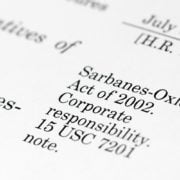When I was presenting at the Silicon Valley Accountants’ Mastering Financial Reporting’s Last Mile conference, this question was raised: “What constitutes a material error in XBRL if the HTML document can be relied upon?” According to the SEC, even if the HTML financial statements are error-free but the corresponding XBRL exhibit has a material error, you must file an amendment to correct the error promptly. In addition, you may voluntarily disclose that the XBRL exhibit should not be relied on either under Item 7.01 or Item 8.01 of Form 8-K.
So the issue here is what constitutes a material XBRL error requiring an amendment? In the absence of specific guidance, we can infer materiality using a quantitative and qualitative analysis from existing accounting literature. Over the decades, the accounting profession has developed quantitative thresholds as rules of thumb for misstatements or omissions. For example, an error that falls under a 5 percent threshold is deemed immaterial. Similarly, for disclosure, other accounting authorities cite guidelines ranging from 1 percent to 10 percent as being not material. Aside from these quantitative yardsticks, the accounting literature views materiality in the light of “surrounding circumstances” if it is probable that a reasonable person will rely on the information to make judgments. This is analogous to how we think of material information in securities law, if there is a substantial likelihood that a reasonable investor would consider it important to an investment decision or if it would alter the “total mix” of available information about a company.
So what defines a material error in the world of XBRL? Let’s model this concept in a multidimensional hypercube similar to an Excel pivot table. To determine materiality in XBRL language, an error should be segmented by dimensions in a metadata model with axis, domain and members. Simply put, material errors should be evaluated based on (1) size; (2) error type (completeness, mapping, accuracy and structure); (3) users of the XBRL information (investors, analysts, and regulators); and (4) relevant facts that impact judgment.
Not all material XBRL errors are created equal: the relative magnitude of a material error may vary, depending on the users, the type of error and how the information was relied on under the relevant facts and circumstances. For example, incomplete tagging, such as missing financial data schedules, may be material in the eyes of investors, analysts and regulators. As a result, this type of error would generally warrant an amended filing. On the other hand, missing calculation links or other structural errors are technical XBRL errors, a clear violation of the SEC Edgar Filer Manual. But is it a material error that requires an amendment? To make that determination, we have to put ourselves in the shoes of the reasonable investor. Would the investor be misled by this technical structural error or was this information useful and nice to have from a data consumption standpoint? Likewise, size alone should not determine materiality. Large errors may be small problems and small errors may be big problems.
While the accounting profession has provided very helpful guidance on materiality, ultimately, when it comes to material XBRL errors, it may lie in the eyes of the beholders: the investors, analysts, regulators and jurors in a court of law—there is no “bright line test” when it comes to materiality in accounting rules or our legal system. If somehow, somewhere there is a probability that someone will be affected by relying on your XBRL exhibit in their decision, then materiality is subject to a 4-D hypercube model analysis of size, error type, data consumers and surrounding circumstances.


